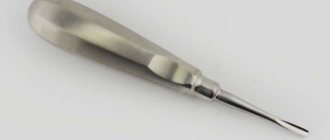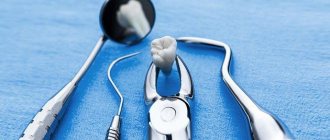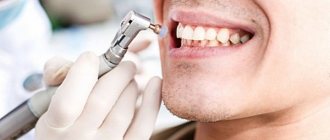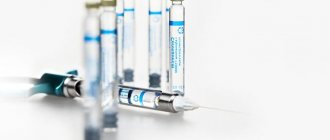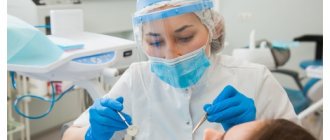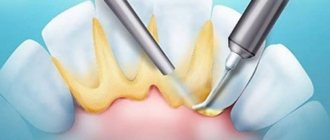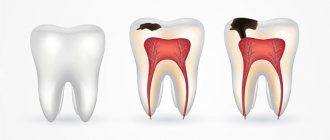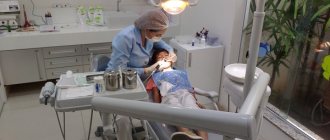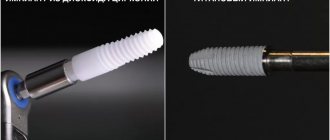Modern hand instruments, when used correctly, provide excellent results for both the doctor and the patient. It should be noted that some of these results can only be achieved using hand tools, not rotary power tools. The shape of the preparation dictates the specific circumstances in which hand instruments must be used, while the accessibility of the preparation may require different conditions.
Hand-held cutting tools are made from two main materials, carbon steel or stainless steel.
In addition, some of them have carbide inserts that add hardness to the cutting edges. Carbon steel is harder than stainless steel, but is susceptible to corrosion if not protected. Stainless steel retains its shine in most cases, but loses its edge sharpness much more quickly than carbon steel. The latter, despite its hardness and wear resistance, is brittle and cannot be used in all tools.
Other alloys containing nickel, cobalt or chromium are also used, but dental preparation instruments are not typically made from such alloys.
Dental treatment tools
To carry out such complex operations, special equipment is used:
- The plugger is ordinary. A tool designed for applying amalgam.
- Plugger for restoration. This tool is used when modeling old amalgam.
- Auxiliary equipment. This category includes all kinds of tools to help with work: spatulas, clamps, suctions, matrices, verifiers, endo files, rimmers, spreaders, pluggers, channel fillers.
- Miller needle. Diagnostic tool for examining the patency of the root canal.
Instrumentation for surgical dentistry
Instrumentation for surgical dentistry is represented by forceps for tooth extraction, elevators and other instruments, as well as general-purpose surgical instruments.
Rice. 4. Dental forceps: 1 - for removing the upper left large molars; 2 - for removing the lower large molars; 3 - for removing lower canines and small molars; 4 - bayonet-shaped for removing the roots of the upper teeth; 5 - for removing the upper molars; 6 - bayonet-shaped (bayonet) for removing upper wisdom teeth; 7 - for removing the upper incisors and canines.
Tooth extraction forceps consist of a working part (cheeks), handles (branches) and a lock. Tooth extraction forceps for adults and children differ in size. In forceps for the teeth of the upper jaw, the axes of the cheeks and handles coincide or are parallel (Fig. 4); forceps for teeth of the lower jaw are beak-shaped, with a bend along the edge and along the plane at an angle from 90 to 110°, depending on which teeth need to be removed (front or lateral). The shape of the cheeks of the forceps is determined by the anatomical structure of the crowns of the teeth, for which they are intended for removal: the cheeks of the forceps for removing teeth with an intact crown do not contact each other and have a concave surface for a reliable grip of the tooth crown; The cheeks of the forceps for removing teeth with severely damaged crowns, roots and incisors converge. S-shaped forceps are designed for removing upper molars; They are made for the right and left sides and are distinguished by the fact that on the outer cheek they have a spike for gripping the recess between the cheek roots. The doctor uses the forceps as a lever, applying considerable effort, which is why they are made massive, made of durable steel; There are notches on the outer surface of the handles so that the forceps do not slip in the dentist’s hand.
Rice. 5. Dental elevators: 1 - T-shaped; 2 - straight; 3 - right; 4 - left.
Elevators for removing teeth and roots are used in the same way as levers when greater force is required. They consist of a working part (its dimensions can be different), a connecting neck and a handle. Their total length is from 141 to 159 mm (Fig. 5). The handles are hollow, faceted, pear-shaped for secure fixation in the hands. Straight elevators are used to remove upper teeth and roots, and curved elevators are used to remove lower teeth and roots; They are also made in two types - with a working surface for the left or right side. A T-shaped elevator with a solid handle and a bayonet-shaped working part is sometimes used to remove third molars, but great care must be taken.
Instruments for surgical dentistry are usually included in sets, for example, a 14-piece set of dental forceps and elevators, a 27-piece set of instruments for removing teeth in children, containing dental forceps, tweezers, raspators, and curettage spoons. Sets of instruments for certain types of plastic surgeries are also produced.
General surgical scalpels and scissors are used depending on the anatomical area where the operation is performed and the nature of the surgical intervention. Ophthalmic scalpels and scissors are often used (see Surgical knives). To bite off the sharp edges of cellular processes, interradicular septa and jaws, bone dental nippers are used, the thin elongated cheeks of the working part of which end with sharp edges.
Instruments for prosthetics
To perform high-quality prosthetics, you need the best equipment. The following tools are included in this category:
- Cutting instruments for preparation (mechanical). Used when working with hard tissues;
- Tools for modeling (dental). Used in the processing of orthopedic devices;
- Impression trays. Materials for taking an impression of the entire jaw or its individual rows;
- Dismantling tool. Necessary for removing old crowns;
- Micrometer. Designed to determine crown thickness;
- Auxiliary equipment. Tools for mixing the solution when installing crowns;
Hardening and heat hardening
To achieve the best properties of carbon and stainless steel, they are subjected to two types of heat treatments: hardening and hardening. Heat treatment gives the alloy hardness, but at the same time makes it brittle, especially with a high carbon content. Thermal hardening reduces stress in the metal and increases its strength. These properties are optimized by manufacturers. Heat of hand-held cutting tools during use can destroy the original properties of the alloys from which they are made and render the tools unusable. Firing over a flame or improper sterilization can easily render a good instrument unusable.
Tools for correcting bite
An orthodontist's instrumentation is very different from previous types of equipment. This specialist’s office should have the following tools:
- Equipment for cutting overgrown tissue. Used to free poorly erupted teeth. As a rule, they are applicable in pediatric dentistry, but there are cases when they cannot be avoided in case of pathology of teething in adults;
- Distal and ligature cutters. Used when shortening the distal arch and cutting the metal ligature;
- Dismantling pliers. Used to remove crowns and braces;
- Reverse grip tweezers. A tool without which installing locks for braces is simply impossible;
- Positioner. Tool for adjusting and installing braces;
- Auxiliary equipment. This group includes Smach, Matthew and Hilgers clamp forceps. They are designed to grip, twist the ligature and apply bends to the ligature arch;
Types of Dental Instruments
Carrying out diagnostic, therapeutic or preventive procedures in dentistry requires the use of a certain set of dental instruments, which differ depending on the type of dental care provided.
The following tools are used to provide therapeutic assistance.
- Instruments for examining the oral cavity.
- Instruments used for dental treatment.
- Tools for removing dental plaque.
- Tools for dental prosthetics.
- Tools for preparing filling material.
- Tools for filling teeth.
- Tools for processing fillings.
- Designs for extracting teeth.
- Instruments for root canal treatment.
To correct the bite and correct the dentition, orthodontic instruments are used - different types of nippers and forceps, scalers, pliers, reverse tweezers, clamps, impression trays, etc.
Surgical treatment is carried out using special surgical instruments designed to prepare and connect tissues, stop bleeding, and perform manipulations in the operated area. These include various types of knives, scissors, wire cutters, scalpels, saws, ligature needles and clamps. The connection of tissues is carried out using needle holders with cutting and stabbing needles.
Restoration of dentition and chewing functions, restoration of dental defects is carried out using orthopedic instruments for dental prosthetics. With its help, various prostheses, crowns and maxillofacial structures are made.
Features of dental equipment from Levant
Why you should order equipment for dental procedures on the Levanta website:
- All tools are made from high quality materials. Our dental products are certified;
- The instruments comply with modern international standards;
- A wide range of;
- Affordable prices, wholesale and retail trade;
- Delivery of goods to any region of Russia;
Levanta specialists will select suitable medical equipment for your clinics and private offices. Absolutely all products of the dental group are covered by a guarantee.
Main directions in surgical dentistry
New technologies, materials, and specialized equipment allow the dental surgeon not only to save a diseased tooth, but also to restore damaged areas. Main directions of surgical intervention:
- Tooth conservation operations
- Treatment of inflammation, removal of tumors in the oral cavity
- Gum plastic surgery
- Surgery for abnormalities
- Complete or partial tooth extraction
- Elimination of consequences of injuries
- Implantation
- Bone grafting
Tooth-preserving operations involve the removal of various formations in the oral cavity, amputation of roots, and periodontal treatment. Surgical intervention allows you to remove infected lesions and save the tooth. The operations are performed under local anesthesia within half an hour.
One of the most common formations in the oral cavity is a root cyst. The disease leads to pain and, in extreme cases, tooth loss. To eliminate it, tooth root resection is necessary. After surgery, the tumor goes away and the tooth becomes healthy.
Bone grafting and implantation
Bone tissue augmentation is resorted to in cases where there is insufficient internal volume to install an implant. This situation often occurs when implantation is performed a significant period after tooth loss. The bone on which it was located begins to dissolve and as a result the alveolar ridge decreases. To properly install the implant, bone augmentation will be required.
The timing of implantation after bone tissue augmentation directly depends on its volume. The more bone tissue has been built up, the longer the period required for its consolidation. Therefore, implantation is performed after complete healing of the bone graft, a period of which can reach six months.
Modern techniques and equipment allow the process to be as pain-free as possible and to carry out high-quality surgical intervention in the shortest possible time, which will result in healthy teeth. Regular, once every six months, visits to the dentist will help to detect the problem in a timely manner and eliminate it with minimal losses.
See also: Teleroentgenogram (TRG) in lateral projection, prices and description.
Pain symptom
The pain symptom is an important indicator for making a diagnosis. By clarifying complaints, the patient is questioned. The dentist determines the causes of pain, its nature (pulsating, twitching, aching pain), time of occurrence (at night or during the day), duration (constant or attacks), and where pain occurs.
All this information forms the basis for making a diagnosis. The duration of existence of symptoms is established, the dynamics of the pathological process is formed. After this, it is necessary to collect information about the treatment being carried out. Was it carried out and, if so, how effective was it? The patient is questioned about previous diseases, allergy and epidemiological history, and working conditions.
An objective dental ( and not only ) examination consists of examination, palpation (basic methods), percussion and a number of additional methods.
Gum plastic surgery
Gum disease is the most common defect in dentistry. It not only spoils the aesthetics of appearance, but also leads to more serious diseases. To eliminate the disease, they resort to gingivoplasty, which consists of creating or removing gum tissue to improve the appearance of teeth and prevent the development of other dental diseases.
Main indications for gum surgery:
- Smile adjustment
- Removal of excess periodontal tissue
- Active prevention of periodontal diseases, root caries
- Improving the structure of gum tissue
- Preparation for prosthetics and implant installation
- Gum injuries
- Cosmetic surgeries
- Chronic inflammation in the oral cavity
- Congenital features, improper dental care, etc.
Gingivoplasty can be performed on a local area of the gum or on its entire surface. The use of one or another type of surgical intervention depends on the volume of treatment. Timely elimination of gum tissue recession will prevent tooth loss and avoid the cost of prosthetics, which are much more expensive than gingivoplasty.
Surgery for abnormalities
Abnormal development and deformation of the jaws manifest themselves mainly as a result of various diseases during the formation of the facial skeleton. The growth of adenoids, various jaw injuries, rickets, and other diseases can affect the development of the jaw even after several years after they have been suffered. Since deformations develop gradually, it is important to detect them in a timely manner to successfully eliminate them.
In most cases, orthodontic intervention during childhood helps prevent development and eliminate anomalies at an early stage. Surgical dentistry is used only in cases where surgical intervention is unavoidable. Basically, operations are performed after the formation of the facial skeleton is completed.
